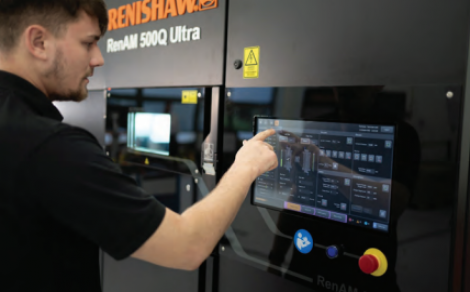Is a bigger bed size always better in Additive Manufacturing?

Stephen Crownshaw, Head of AM Sales at global engineering technologies company, Renishaw, explores how bed size impacts productivity in Additive Manufacturing
The trend of increasing bed sizes in additive manufacturing (AM) is gaining momentum. Larger bed sizes are essential for producing large components, but some manufacturers are using these bigger systems for the volume production of smaller parts. However, smaller machines, optimised for productivity, could offer a better return on investment (ROI).
The importance of reducing costs
Reducing cost per part is crucial for the broader adoption of AM technology. Since a significant portion of part costs is generated during on-machine build time, original equipment manufacturers (OEMs) have prioritised machines that can reduce the time per part. One approach to achieve this is by making machines larger to accommodate higher volumes of parts. While the standard bed size for many AM machines is 250 x 250 mm, machines with build areas exceeding one metre are now available.
Is a larger bed size necessary?
The most obvious reason to opt for a larger bed size is if you are producing large parts that cannot fit within a standard 250 x 250 mm footprint. However, most components produced using metal AM tend to be smaller. Crownshaw notes that approximately 80 per cent of the parts customers inquire about are designed to fit within a standard bed size. These include small structural components for automotive frames or medical implants.
For those seeking to produce small parts in volume, a larger platform is not always the most efficient option. While a bigger machine can produce more parts per build, it does not necessarily guarantee greater efficiency or productivity. To achieve optimal productivity, manufacturers must carefully assess their specific application and determine which machine is best suited to their needs.
Key considerations around bed size
When choosing a machine with a larger bed size, several considerations need to be taken into account. Firstly, is your manufacturing process equipped to handle a large number of parts being produced at once? For instance, downstream processes such as heat treatment, blasting, and post-processing could become bottlenecks if the system is producing too many parts at once.
Another potential drawback of using a large machine for small part production is the increased risk of build failure. If a failure occurs during the production of many parts on a single large machine, the impact could be more significant than if the parts were spread across multiple smaller machines.
ROI is another crucial factor. Large machines often come with a higher price tag, which can lead to longer payback times. In some cases, investing in two smaller machines may deliver better ROI, while also managing the risks associated with build failure and facilitating a smoother production process.
Alternative approaches to productivity
There are other ways to boost productivity in AM that do not involve increasing bed size. Technologies that increase laser-on time, improve machine turnaround, and streamline powder handling can all contribute to greater efficiency.
For instance, integrating powder handling processes like sieving directly into the machine can reduce the time spent removing unmelted powder for recirculation. Additionally, some manufacturers are incorporating vacuum processes that allow the machine to start processing more quickly by removing oxygen faster, thereby reducing the need for consumables like argon gas.
One of the most significant challenges in improving laser-on time in laser powder bed fusion machines has been recoating time. Traditionally, the laser stops firing during the recoating process, which can slow down the build. Recoating times of around nine to eleven seconds per layer can add up to tens of hours over the course of a build that involves thousands of layers.
By making AM systems faster and more efficient, manufacturers can reduce the cost per part and increase production output — without necessarily requiring a larger machine. For businesses considering whether to invest in machines with larger bed sizes, it is essential to weigh up the specific demands of their application, the risks involved, and the overall impact on productivity and ROI.
For further information please visit: https://www.renishaw.com
https://twitter.com/renishawplc
https://www.linkedin.com/company/renishaw/
-
PPMA 2025
23 September, 2025, 9:30 - 25 September, 2025, 16:00
NEC, Birmingham UK -
Advanced Engineering Show 2025
29 October, 2025, 9:00 - 30 October, 2025, 16:00
NEC, Birmingham UK










